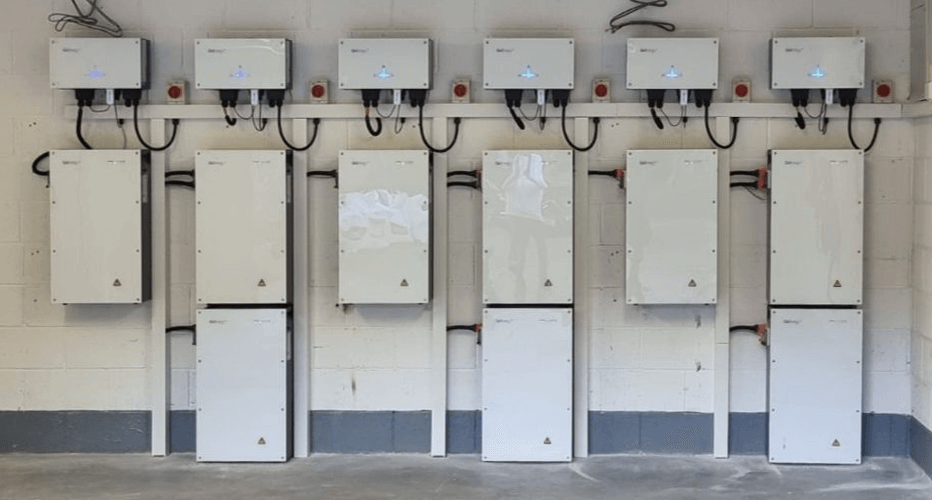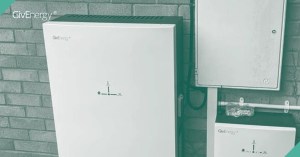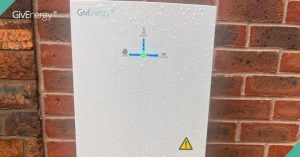Getting started with...
Domestic battery storage
Getting started with…
Domestic battery storage
-
Domestic battery storage reduces the average household’s bills by 85%

-
With a home battery, you can cut your home carbon emissions by >300kg per year

-
You can integrate your battery storage system with smart tariffs to capitalise on low off-peak rates

-
Domestic battery storage reduces the average household’s bills by 85%

-
With a home battery, you can cut your home carbon emissions by >300kg per year

-
You can integrate your battery storage system with smart tariffs to capitalise on low off-peak rates

Domestic battery storage refers to the use of an energy storage system in your home. It involves the installation of a home battery, designed to store energy to power your property cheaply and cleanly.
You’ll no doubt have lots of questions before investing in a home battery. So, we’ve prepared a handy guide to help you get started on your domestic battery storage journey.
What’s on this page?
-
| How does domestic battery storage work?| How does domestic battery storage work?
01
-
| What are the components of a domestic battery storage system?| What are the components of a domestic battery storage system?
02
-
| What are the benefits of domestic battery storage?| What are the benefits of domestic battery storage?
03
-
| Can I add domestic battery storage to an existing solar array?| Can I add domestic battery storage to an existing solar array?
04
-
| What if I don’t have a renewable energy supply?| What if I don’t have a renewable energy supply?
05
-
| Is my home suitable for domestic battery storage?| Is my home suitable for domestic battery storage?
06
-
| What battery capacity do I need?| What battery capacity do I need?
07
-
| How are storage batteries fitted?| How are storage batteries fitted?
08
-
| Will I need to manage my domestic battery storage solution?| Will I need to manage my domestic battery storage solution?
09
-
| How long will my home battery live?| How long will my home battery live?
10
01 How does domestic battery storage work?
Domestic battery storage systems give you the ability to run your property on battery power. With a storage battery in place, you can store green energy for later use – meaning you don’t have to draw from the grid during peak hours.
In the first instance, a storage battery can take its charge from renewables. (I.e., from solar panels, or wind or hydro turbines.) So, you can charge your battery using free, green sources. And, because the energy from renewables is intermittent, a storage battery allows you to harness it more efficiently for consistent use.
In the second instance, a storage battery can also take power from the grid. Here, the battery will charge using low-cost, off-peak energy. (Such as overnight, for example, when electricity from the grid is at its cheapest and cleanest.)
Whether you use renewables, the grid, or both, your home storage battery gives you the freedom to choose when (and how) you buy and use your energy.

02 What are the components of a domestic battery storage system?
A standard domestic battery storage system will typically comprise:
- A home battery - where your energy supply is stored,to discharge into the home and/or into your EV
- An inverter -the brains of your system, connecting any renewables, batteries,the grid, and the home
- Energy management software – where you can track and manage your energy usage via the cloud or via app
You may also have a range of complementary products such as EV chargers, smart plugs, voltage optimisers, and so on.
03 What are the benefits of domestic battery storage?
First, a domestic battery storage system will reduce your energy bills by circa 85%. You have energy stored up, which means you can manage it efficiently. So, you’re less reliant on the grid, and not beholden to peak charges.
As well as these initial savings, your battery system will enable you to get smarter about your energy usage over time. Energy management software gives you all the data you need to monitor your system and continue reducing your spend month after month.
Then, if you’ve also invested in renewables, domestic battery storage provides the means for you to maximise that investment. If, for example, you’ve paid for solar panels but have no storage capacity, you can only use solar energy intermittently. Your panels won’t power your home during evenings, for instance. Adding a home storage battery means you can get the most from your renewables and enjoy cheap energy morning, noon, and night.
Plus, this concept of consistent low-cost energy also applies during outages. With domestic battery storage, you can protect your supply from disruption, keeping your home powered even when the grid is down. (Dependant on your setup.)
Last but not least, smarter energy management is an environmentally responsible move that reduces your carbon footprint. When the demand on the grid is high, we need to rely on fossil fuels to ensure everyone can use electricity at the same time. Having energy stored cuts this reliance on using the grid during peak hours. So, your domestic battery storage system can clean up the grid, cut your home’s CO2 emissions, and help you do your bit towards a net zero world.
04 Can I add domestic battery storage to an existing solar array?
Absolutely – in fact, we highly recommend doing so. If you already have solar panels fitted, but don’t have storage capacity, an AC coupled inverter paired with a home storage battery will work as a perfect retrofit solution.
In this instance, your solar panels stay untouched. Meanwhile, any existing Feed in Tariff will also continue as normal. An installer would simply come and fit your domestic battery storage system, adding an AC coupled inverter to communicate between solar PV, the battery, and the home.
So, the power from your existing solar array will charge the battery, the battery will supply the home, and any leftover energy is sent back to the grid. No changes to your panels or tariffs needed.
05 What if I don’t have a renewable energy supply?
If you don’t have renewables, that’s fine too. A domestic battery storage system will still work effectively without solar PV or a turbine in place.
Here, the storage battery can work strategically with smart energy tariffs. It will charge using off-peak rates (usually overnight) – meaning you store energy only when it’s super cheap to do so. Then, it will discharge during peak times. So, your home will automatically switch to battery power instead of drawing from the grid when it’s costliest.
In fact, according to data from our energy management software, this kind of smart tariff manipulation using a home battery can save customers £1500 per year – even without renewables.
06 Is my home suitable for domestic battery storage?
Any home can benefit from domestic battery storage. Storage batteries come in a variety of sizes and capacities to meet the power needs of any property.
For example, our domestic range offers everything from compact batteries with a 2.6kWh capacity (perfect for small properties), right up to powerful batteries with an enormous 13.5kWh capacity (enough for even the highest-consumption households).
Simply, as long as your home uses energy, it’s suitable for energy storage solutions.
07 What battery capacity do I need?
Your needed battery capacity depends on variables such as:
- The size of your home
- The number of residents in the home
- Whether you have high-consumption power needs (EVs, hot tubs, swimming pools, etc)
- How much energy you generate (or will generate) from any renewables in place
To answer to these variables, our home batteries range from 2.6kWh capacity to 13.5kWh capacity. You can also choose to have more than one battery installed if your needs are high. Plus, you can easily scale your setup by adding more batteries in future.
Your GivEnergy installer will be able to recommend the best domestic battery storage system for you after learning more about your needs and setup.
08 How are storage batteries fitted?
Your GivEnergy battery system must be fitted by an approved installer. The installer will talk you through appropriate installation locations when they come to assess your project.
When it comes to positioning, the battery storage system is designed to be wall mounted or ground mounted, and always kept in an upright position.
Then, when it comes to location, all our storage batteries are IP65 rated. (Meaning you can have them inside or outside of your home, as preferred.) If fitted indoors, your battery should be placed away from direct heat sources. When outdoors, it should be housed beneath a canopy. With any installation – indoors or outdoors – your installer should leave adequate clearance around the system for ventilation.
Generally, your installer will be able to fit and commission your domestic battery storage solution within a single day.
09 Will I need to manage my domestic battery storage solution?

Once installed, your domestic battery storage solution will just work. So, if you prefer, you can set it and forget it. The system will set to ECO by default, ensuring that it works dynamically to maximise your self- consumption. Plus, inbuilt algorithms mean that your battery will charge and discharge intelligently – automatically taking advantage of cheap rates.
All this means that, once set up, there’s no need for you to lift a finger or manually tell the system what to do. However, you can also take a more hands-on role if you prefer. For example, you can set schedules and timers to configure your energy usage around your lifestyle. You can make continuous changes and optimisations via the portal. You can adjust on the fly via the app. And, for the more technical user, you can even use the GivEnergy API to set custom automations.
So, you can be as hands-on or hands-off with your system as you like.
10 How long will my home battery live?
Your GivEnergy domestic battery storage solution is built to last. We protect our batteries with a full manufacturer’s warranty that covers you for 12 years. So, you’ll get a minimum of a decade from your home battery.








